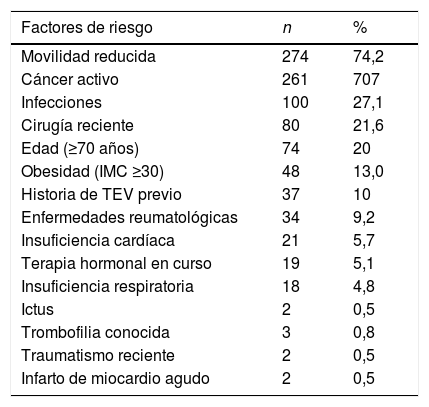Identificar la frecuencia de los factores de riesgo del tromboembolismo venoso en pacientes hospitalizados y el uso de medidas preventivas adoptadas por los profesionales de la salud.
MétodoEstudio descriptivo, transversal y retrospectivo que incluye registros médicos de 369 pacientes adultos hospitalizados en un hospital universitario en São Paulo, Brasil, durante al menos 48 h, del 2015 al 2017. Se investigaron datos sociodemográficos, factores de riesgo clínicos para el tromboembolismo venoso, contraindicación para profilaxis química, implementación de profilaxis química y mecánica y ocurrencia de la enfermedad. Se calculó el uso de medidas preventivas siguiendo las directivas de la Sociedad Brasileña de Medicina Clínica y el riesgo de tromboembolismo venoso según la escala de predicción de PADUA (alto riesgo ≥ 4 y bajo riesgo < 4).
ResultadosLa prevalencia de tromboembolismo venoso fue del 7,3% (n = 27). Todos los pacientes tenían al menos un factor de riesgo de tromboembolismo venoso, siendo más prevalentes la movilidad reducida (74,2%), el cáncer activo (70,7%), la infección (27,1%), la cirugía reciente (21,6%) y la edad ≥ 70 años (20,0%). Se implementó la profilaxis química en el 70,3% de los pacientes de alto riesgo sin contraindicación y la profilaxis mecánica se aplicó solo en uno de los casos con indicación.
ConclusioneTodos los pacientes tenían al menos un factor de riesgo de tromboembolismo venoso; sin embargo, hubo una baja tasa de implementación de medidas preventivas por los profesionales de la salud. Por lo tanto, existe la necesidad de múltiples intervenciones, incluida la educación durante la admisión y la educación permanente de enfermeros en relación con los riesgos y la prevención, los sistemas de alerta y la auditoría de resultados.
To identify the frequency of risk factors for venous thromboembolism in hospitalized medical patients and the use preventive measures by healthcare professionals.
MethodA descriptive, cross-sectional, retrospective study including medical charts of 369 adult patients hospitalized in the Medical sector of a university hospital in São Paulo, Brazil, for at least 48h from 2015 to 2017. Sociodemographic data, clinical risk factors for venous thromboembolism, contraindication and implementation of chemical prophylaxis, and the occurrence of the disease were investigated. The use of preventive measures was calculated by following the guidelines of the Brazilian Society of Clinical Medicine and the risk of venous thromboembolism according to the Padua Prediction Score (high risk ≥ 4 and low risk < 4).
ResultsThe prevalence of venous thromboembolism was 7.3% (n = 27). All patients had at least one risk factor for venous thromboembolism, the most prevalent being reduced mobility (74.2%), active cancer (70.7%), infection (27.1%), recent surgery (21.6%) and age ≥70 years (20.0%). Chemical prophylaxis was implemented in 70.3% of high-risk patients without contraindication and mechanical prophylaxis was applied in only one of the cases with an indication.
ConclusionsAll patients had at least one risk factor for venous thromboembolism. However, there was a low rate of implementation of preventive measures by health care professionals. Therefore, there is a need for multiple interventions, including admission and permanent education of nurses regarding risk and prevention, warning systems and outcomes audit.







